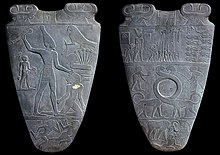Bat (goddess)
Bat is a
Worship
The worship of Bat dates to earliest times in ancient Egypt and may have its origins in Late Paleolithic cattle herding cultures. Bat was the chief goddess of Seshesh, otherwise known as Hu or Diospolis Parva, the 7th nome of Upper Egypt.
Name
The epithet, Bat, may be linked to the word Depictions in ancient Egyptian culture
Although it was rare for Bat to be clearly depicted in painting or sculpture, some notable artifacts (such as the upper portions of the
Bat became strongly associated with the sistrum and the center of her cult was known as the "Mansion of the Sistrum".[3] The sistrum is an ankh-shaped musical instrument,[4] which was one of the most frequently used sacred instruments in ancient Egyptian temples. Some instruments would include depictions of Bat, with her head and neck as the handle and base and with its rattles placed between her horns. The imagery is repeated on each side of the instrument, having two faces, as mentioned in the Pyramid Texts:.
- I am Praise; I am Majesty; I am Bat with Her Two Faces; I am the One Who Is Saved, and I have saved myself from all things evil.[5]
Relation to Hathor
The imagery of Bat as a divine cow was remarkably similar to that of Hathor, a parallel goddess from another nome. In two dimensional images, both goddesses often are depicted straight on, facing the onlooker and not in profile in accordance with the characteristic Egyptian convention. The significant difference in their depictions is that the horns of Bat curve inward and those of Hathor curve outward slightly. It is possible that this could be based in the different breeds of cattle herded at different times.

See also
References
- ISBN 0-500-05120-8
- ^ Barbara Lesko Great Goddesses, 100, p. 81
- ISBN 0-415-34495-6
- ISBN 0-500-27751-6
- ^ R. O. Faulkner, The Ancient Egyptian Pyramid Texts, Oxford 1969, p. 181, Utterance 506

